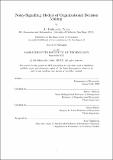Noisy-signalling models of organizational decision making
Author(s)
Palida, Ali Fakhruddin.
Download1227094325-MIT.pdf (648.3Kb)
Other Contributors
Massachusetts Institute of Technology. Department of Economics.
Advisor
Robert Gibbons and Glenn Ellison.
Terms of use
Metadata
Show full item recordAbstract
This thesis consists of three separate papers concerning the use of communication channels and intermediaries in organizations. A noisy-signalling model of strategic communication is introduced in the first chapter, and expanded upon in the remainder of the thesis. In the second part of the first chapter, I use the core noisy-signalling model to study organizational design of a single channel of communication. The results of the analysis provide a rational for the variation in communication processes observed across organizations, as well as costly political lobbying and advertising campaigns. In the second chapter, I extend the core model to allow the informed party to choose among multiple communication channels when conversing with the decision maker. The model suggests that polarization across communication channels may be an efficient response to "bandwidth" concerns facing decision-makers of large corporations or unqualified management. Conversely, coexistence of partisan and non-partisan channels within an organization or community (e.g. tabloids and professional news sources in the journalism industry) may also be socially efficient for other environments. In the third chapter, I consider a different extension of the core model by allow- ing the two parties to communicate via a strategic intermediary. I use the model to provide a possible explanation for the variety of roles communication intermediaries play in different organizations, the correlation between control-rights and communication hierarchies in organizations, as well usage of third-party, conflict-resolution arrangements.
Description
Thesis: Ph. D., Massachusetts Institute of Technology, Department of Economics, September, 2020 Cataloged from student-submitted PDF of thesis. Includes bibliographical references.
Date issued
2020Department
Massachusetts Institute of Technology. Department of EconomicsPublisher
Massachusetts Institute of Technology
Keywords
Economics.